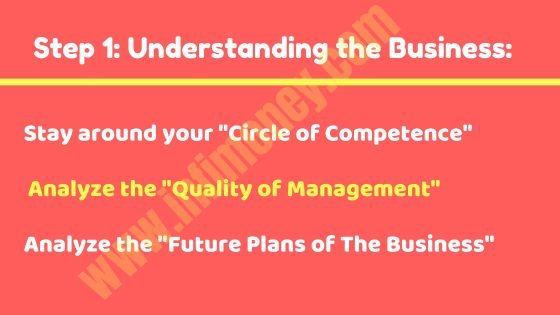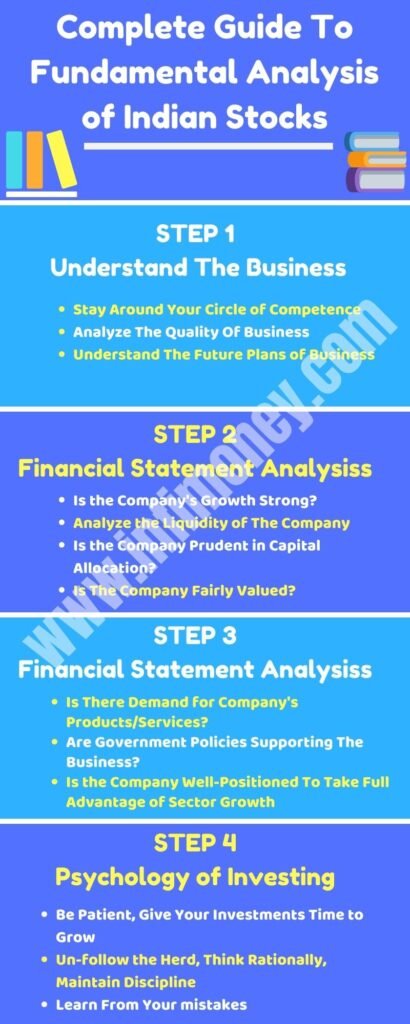Hi investors, in this post of “Complete Guide to Fundamental Analysis of Indian Stocks”, you will understand each and every aspect of analyzing the fundamentals of a business, and how you can become an expert stock picker.
Introduction to Fundamental Analysis of Indian Stocks
Fundamental analysis has always been the best way of stock picking. It is something that is practiced by some of the most successful investors across the world such as Warren Buffett, Peter Lynch, John Templeton etc.
Warren Buffett’s Company Berkshire Hathaway, over the past 50 years have compounded their investor’s wealth by 20.9%. In other words, Rs.1,000 invested in Berkshire Hathaway 50 years back would become Rs. 1,32,22, 544 (Rs.One Crore Thirty Two Lac Twenty Two Thousand Five Hundred Forty Four)
Similarly, Peter Lynch, fund manager of Magellan fund Under Fidelity Investment from 1977 to 1990 gave a compounded return of 29.2%.
The phenomenal success achieved by these investors shows that fundamental analysis has been a time tested, proven and the best way of analyzing and picking stocks.
What is Fundamental Analysis?
Fundamental analysis is about analyzing the business and financial performance of the company in order to understand its current valuation and future growth potential and make an investment decision.
The question now is why fundamental analysis is so important? To answer this question, you need to understand what is a stock or share.

What is a Stock?
Every stock (or share) is a part of your ownership in a business. When you buy a share, you buy a small portion of a business.
When companies do well, they earn bigger profit, thereby increasing the value of the business.
Since stocks are part ownership in the business, the price of the share appreciates proportionately.
In order to understand which businesses are doing well, and will continue to do well in the future, you must analyze various aspects of the business such as the business model, past performance, future growth potential and its business value against market price.
In other words, fundamental analysis helps you in answering following questions:
What is the business of the company (Business Model)
How well the company has performed in the past?
What are its future growth prospects?
Is it the right price to enter into stock?
In our guide to fundamental analysis of Indian stocks, you will learn to analyze each of these aspects step by step.

Understanding the Business
The first step to fundamental analysis of Indian stocks, is to understand the business of a company.
There are more than 5,500 listed companies in Indian stock market, it is impossible to analyze all of them and pick a few.
That is why you should invest in only those businesses that fall under your “circle of competence”.
What’s that? The concept of circle of competence was introduced by Warren Buffett. This is how he has explained it.
“I expect to make money from the things that I understand, where I can foresee how the economics of the business are going to look like 10-15 years in the future.
I am not an expert in understanding everything so I stick to the businesses that I understand, and I call it my circle of competence, and try to stay around my circle of competence”
Put simply, One cannot be an expert in understanding all types of businesses.
There are some you will understand better and others that you don’t. Businesses that you really understand well are within your circle of competence.
As an investor, it is always in your favor to invest in businesses that you understand.
When you understand the business well, you also understand the inner workings of the company and the factors that may work in favor or against the business.
All of this helps you understand the future economics of the business and how business is supposed to pan out.
But how do you know what is your circle of competence? It is often seen that businesses with simple business models are usually easier to understand and thus fall under our circle of competence.
Let me give you a simple example.
Do you understand the business model of Britannia Industries?
Yes, they make quality confectionery products, such as cookies, cakes and biscuits.
They have a strong brand trusted by many allowing them to charge a premium price from their customers.
How do you see Britannia 10 years from now? Since there is rising demand for such products, and there are few players in the market that can compete with Britannia, I think Britannia will continue to grow for the next 5-10 years.
Now let’s look at another business. Infosys.
Do you understand their business model? Not very clearly, but, they provide software solutions to clients from various sectors
How do you see Infosys 10 years from now? It’s hard to say if they will remain market leaders 10 years from now as there are many other players like TCS, Tech Mahindra, Wipro, etc.
If understanding business model Britannia is much easier than Infosys, Britannia fall under your circle of competence while infosys does not.
The second step in our Guide to Fundamental Analysis of Indian Stocks is to analyze the management of the company.
Understanding the Management
The second key step to fundamental analysis of Indian stocks is to understand the management.
A good management is always vocal about its business, its current situation, opportunities, future growth plans.
You can find all the information related to business growth plans in company’s annual report under “Management Discussion and Analysis” section.
A good business should clearly state its future expansion plans, how it’s going to achieve them and steps being taken in that direction.
A management using vague statements while explaining its business, using lot of complex jargons, should be carefully dealt with.
For Example, if a company says “We expect to see exponential growth in the coming years” but fails to answer “How?” better be careful with such people, chances are they may not have any plans at all.
On the other hand, if a company says “We expect to grow at 20% in the next 5 years” and presents a concrete plan on how it is going to achieve them, you can trust the honesty of the management.
Also, it is always better to have right mix of people running the business. Make sure that people in top management have sufficient experience in relevant industry and have a successful track record.
Companies that have directors with little or no experience may not be able to understand the intricacies business and thus may not be able to take the business forward.
In order to understand who are the directors and their work experience look at the annual report and you will find all the relevant information under the heading “Corporate Information”.
To some, this may not look like an important aspect of fundamental analysis, but it is. A dishonest management can destroy a great business.
A Forward Looking Management
A business should always be forward looking in order to grow. A good business has a forward looking management, and should be able to plan accordingly.
This not only helps company stay ahead of the competitors but also helps them expand business their business in a better way.
To give you an example of a forward looking management, HUL (Hindustan Unilever Limited) a leading FMCG company understood earlier that consumers are now more inclined towards ayurvedic products over cosmetic ones, and launched a series of ayurvedic products under brand name “Lever Ayush”, to capture the rising demand.
In short, an ambitious and forward looking management which is also vocal and transparent about its future plans takes the business forward.
Financial Statement Analysis
The third step in Fundamental Analysis of Indian Stocks is to analyze the past performance of the business, which can best be understood by analyzing its financial statements.
It is usually believed that you need a degree in finance to understand the financial statements of a company.
Trust me, you don’t have to be an expert in finance to analyze the financial statements.
Today by using financial ratios, it has become much easier to analyze financial performance of a company than it was many years back.
You just have to look at few crucial ratios in order to understand the complete picture of the financial performance of a company.
Earnings Growth
Earnings growth is a great measure to understand how fast a company’s business is growing. There are many parameters that can be used to assess the earnings growth of the company, but the most accurate is calculating the EPS growth.
EPS stands for Earnings Per Share, calculated by dividing Net Profit by number of outstanding shares of the company. EPS growth is percentage growth in earning of a business compared to previous year.
To calculate EPS growth, you need to use the following formula:
EPS Growth = EPS(current Year)-EPS(previous year)/EPS(previous year)*100
Some conservative investors also look for past 5-10 years of EPS growth, based on their investment horizon.
Word of Caution: Some companies can manipulate EPS numbers using creative accounting methods.
For Example, a company may announce buyback of shares, thereby reducing number of outstanding shares in the market. This boosts the EPS numbers without any real growth in earnings.
Investors using EPS growth as a metric should make sure company has not announced any buybacks recently.
Liquidity Status
Liquidity is the ability of a company to meet its financial obligations, such as interest payment on loans, payment to its creditors etc.
Liquidity is an important metric as it determines if a company will be able to run its business smoothly after paying all its obligations.
There are two types of liquidity, short term and long term. Short term liquidity measure whether the company will be able to meet all its financial obligations that are due this year.
The best measure of short term liquidity is Current Ratio which can be calculated using this formula
Current ratio = current assets – current liabilities
Although you don’t have to go through the pain of calculating this number as it is easily available on many websites like Moneycontrol.com.
Simply search the name of the company and on the left side bar and go to Financials > Ratios. You will get all the important ratios for the past 5 years of the company.
As a thumb rule companies with current ratio of 1 or above are supposed to be sufficiently liquid.
The second is the long term liquidity ratios, which signifies of the company is able to meet its long term obligations.
If a company has poor long term liquidity, it may default on its loans and even file for bankruptcy. There are many examples in the recent past where companies(such as Lanco Infra, Kingfisher Airlines) went bust as they were unable to meet their long term financial commitments.
The best way to assess the long term liquidity of a company is Debt to Equity ratio.
It is calculated by dividing total long term debt by shareholders Equity
Debt to Equity = Total Debt/Shareholder Equity
An ideal level of debt to equity ratio is that it should be below 1. However, debt to equity varies from industry to industry and is usually seen on the higher side in capital intensive sectors (such as Infrastructure, Iron and Steel, Power generation etc).
Note: While analyzing Non Banking Finance Companies or Banks, it is better to look at their NPA numbers rather than debt to equity.
Again, you don’t have to calculate these numbers as you can easily find them on Moneycontrol.com.
Word of caution: Just like earnings numbers, even debt to equity ratio can be manipulated if company goes fro equity dilution, resulting in issuing more equity shares.
Efficiency Ratios
Efficiency ratios are used to measure how efficiently the capital of the company is allocated. In other words, it shows how prudent the management is in terms of allocation money in such a way that it maximizes the return on invested capital.
The best way to assess capital efficiency is to look at Return on Capital Employed(ROCE), which is calculated using the following formula.
Return on Capital Employed = Net Operating Profit/Capital Employed.
Some analysts also use Return on Equity as a capital efficiency metric, but in my opinion, ROCE is a more conservative measure as it measures capital efficiency using both debt and equity of the company.
An ideal level of Return on Capital Employed should be higher than prevailing interest rates and inflation of the country.
Valuation Ratios
Valuation is the most important step while performing Fundamental Analysis of Indian Stocks as it not only helps you understand what the business is worth and how much you are paying for it(also called absolute valuation), it also helps you in peer comparison, that is, compare two or more similar companies in the same sector to understand which one is cheaper(called relative valuation).
Although there are many valuation ratios such as EV/EBITDA, Price to Book Value, etc, we are going to focus on two most popular and efficient valuations ratios. The Price to earnings Ratio and Price to earnings growth ratio (PEG ratio).
Price to Earning Ratio: popularly known as the P/E ratio, it is calculated by dividing the current market price of the share by EPS.
P/E Ratio measures how much price an investor is paying against each rupee earned by the company. For example if a company is trading at a P/E of 10, it means that investors are paying Rs. 10 for each rupee earned by the company.
Assume two companies in the same sector, one is trading at a P/E of 10 and other is trading at a P/E of 8.
As its obvious, company trading at P/E of 8 seems to be cheaper and hence a better investment.
The problem with P/E Ratio is that it assumes that both the companies are growing at the same growth rate, which may not always be the case.
Different companies, despite being in the same sector, may grow at different growth rates.
when a company grows rapidly, investors usually pay higher price for perceived higher growth in the future, pushing P/E ratio higher for such companies.
To make a better comparison between companies with different growth rates, we use a better metric called PEG ratio,
PEG Ratio: PEG ratio is a more advanced version of P/E ratio that takes into account the expected growth of the company as well. PEG ratio is calculated by dividing P/E ratio with estimated future growth rate of the company.
As a thumb rule, lower the PEG number, better it is. If the PEG ratio is below 1, the stock is assumed to be undervalued.
For example, assume two companies, X and Y. While X is trading at a P/E of 5 and Y is trading at a PE of 8. By just looking at the P/E it seems X, being lower P/E, is a better bargain.
Let’s now look at the expected growth rates of both the companies.
Expected Growth Rate of X 5% CAGR
Expected Growth Rate of Y 12% CAGR
Now dividing P/E ratio by its expected growth rate, here are the respective PEG Ratios.
PEG Ratio of Company X 5/5=1
PEG Ratio of Company Y 8/12=0.66.
As you can see clearly, the picture has changed completely. Despite having higher P/E Ratio, Company Y is still a bargain compared to Company X.
While performing relative valuation, it is always wise not to rely on a single metric and cross check your analysis using different valuation ratios to test your assumptions.
Macroeconomic Support
The third step to Fundamental analysis of Indian Stocks is understanding the macroeconomics. No matter how good the business is, it cannot survive for long time if it is not supported by the economy. Macroeconomic analysis involves study of broader economic factors that support the growth of business.
You don’t have to be an economist to perform macroeconomic analysis, just ask few simple questions such as:
Is there a demand for the products/services of the company?
Are Government Policies supporting the business growth?
Is the company well positioned in the market to take full advantage of growth in the sector?
For Example, Let us analyze food processing sector. Ask these questions to yourself.
Is there a demand for processed foods in India?
The answer is yes, with more women joining the workforce(especially in urban and semi urban areas), they may not have the time to cook food. In such cases, there will be huge demand for semi cooked to ready to eat canned food that can be consumed instantly.
Is the Government Policy Supporting the Food Processing Industry?
Yes, Government is willing to offer land for food parks to various companies as these food parks also provide better price to farmers produce.
Is the Company well positioned to take full advantage of the growth in the sector?
Many companies like Nestle have launched new range of products to serve the market, also many companies like ITC have also entered processed food business offering frozen veggies that can last longer.
All these answers show that food processing companies have a bright future ahead, and worth being invested for long term.
Macroeconomic factors plays a significant role in growth of any sector, but it’s hard to go by numbers while analyzing macroeconomics as there are too many variables that may lead to lot of confusion.
The best way to perform macroeconomic analysis is to keep it simple and do not bother about daily changes or fluctuations.

Understand The Psychology of Investing
The final step in our Guide to Fundamental Analysis of Indian Stocks is something that is seldom talked about, but is a very important part of successful investing.
Warren Buffett once said “Investing is 20% strategy and 80% psychology”, which shows how significant is the role of psychology in fundamental analysis.
No matter how good your stock picking skills are, if you don’t have the right mindset and discipline, you can be your own worst enemy.
So how do you approach the market in order to take maximum advantage of other people’s irrational behaviour, while preventing yourself from not being carried away by herd mentality?
Here are three most important disciplines to be followed while investing in stock market:
Be Patient
Investing in stock market is neither a lottery nor a gamble, that can make you rich overnight. Look at some of the most successful investors in the word, it took them decades to be where they are today.
When you invest in stocks, you own a part of a business. When businesses grow and earn bigger profits, their total business value increases. But since that does not happen overnight, you have to give it time and be patient.
Investing in stocks is like planting a seed, you have to be patient in order to get meaningful results.
So once you have found a great stock to invest in, don’t be hasty, maintain discipline and give it chance to grow.
It’s as boring as watching the paint dry or grass grow, but if you are serious about making money from investments, you have to follow the rules of the game.
Un-follow the herd
When the market nosedives, news channels show everything going bad in the market, and all the stocks are deep in red, it’s hard to keep your calm and stay invested.
But if you think rationally, this is the time when quality stocks are available at a bargained price.
Successful investors do not focus on popular opinion, they focus on the price of the stock and its underlying value.
If the underlying fundamentals of the company are largely unaffected, but the price has corrected significantly, it’s always wise to grab such an opportunity, as it will give you multifold returns in no time.
Learn from your mistakes
No matter how good your stock picking skills are, you cannot avoid making a mistake altogether.
This does not mean that you should get disheartened and quit. Successful investors revisit their mistakes and learn from them, trying to avoid making the same mistake in the future.
Remember, learning is a continuous process that never stops, it helps you gain experience and become a better investor.
So be mistake friendly, and gain experience from them. Slowly you will find your regrets going down while your bank balance going up.
Before I conclude this Post with final points, let us summarize all the points we have learned so far through the info-graphic given below:

Conclusion
Performing fundamental analysis of Indian Stocks is not difficult, but it takes some time to learn, but if you are dedicated to learning fundamental analysis of Indian stocks, it becomes much easier.
As already mentioned earlier, discipline plays an important role in successful investing. While performing fundamental analysis of Indian stock, you must not ignore the fact that no matter how good your stock picking skills are, it’s of little use if you are not disciplined or easily influenced by popular opinions of other people.
That concludes our guide to fundamental analysis of Indian Stocks, hope you find this useful and knowledgeable.